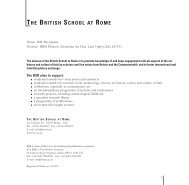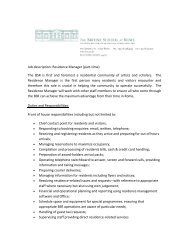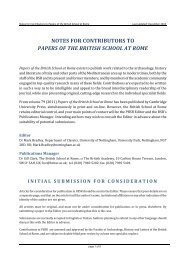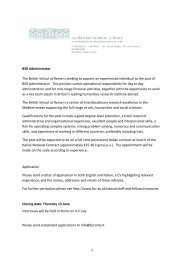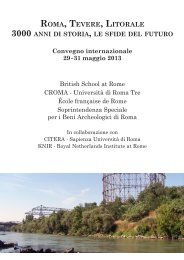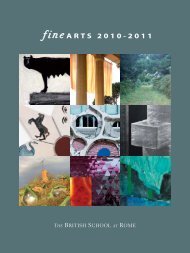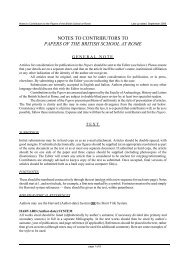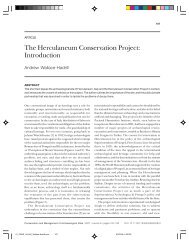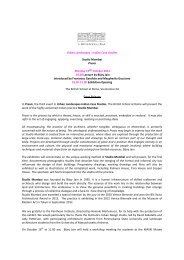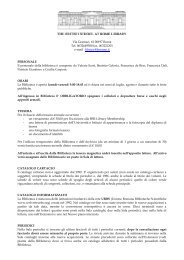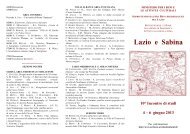FORUM Strutture, funzioni e sviluppo degli impianti forensi in ...
FORUM Strutture, funzioni e sviluppo degli impianti forensi in ...
FORUM Strutture, funzioni e sviluppo degli impianti forensi in ...
You also want an ePaper? Increase the reach of your titles
YUMPU automatically turns print PDFs into web optimized ePapers that Google loves.
<strong>FORUM</strong><strong>Strutture</strong>, <strong>funzioni</strong> e <strong>sviluppo</strong> <strong>degli</strong> <strong>impianti</strong> <strong>forensi</strong><strong>in</strong> Italia (IV sec. a.C.- I sec. d.C.)G.De Nittis, Il Foro di Pompei II, 1875, olio su tavola.Roma9 – 10 dicembre 20139 dicembre, ore 9, Università di Roma ‘La Sapienza’, Aula Odeion10 dicembre, ore 9, British School at Rome, Sa<strong>in</strong>sbury Lecture TheatreOrganizzato da:Christopher Smith, British School at RomeAttilio Mastroc<strong>in</strong>que, Università <strong>degli</strong> Studi di VeronaEnzo Lippolis, Università <strong>degli</strong> Studi di Roma ‘La Sapienza’Lo spazio forense costituisce il centro organizzativo, politico, sociale e rappresentativo di unacomunità romana. Nella letteratura augustea emerge come tratto dist<strong>in</strong>tivo e completamenteformato della città romano-italica; elemento peculiare e determ<strong>in</strong>ante, viene replicato nel sistemacoloniale e nei processi di adeguamento culturale <strong>in</strong> atto nelle diverse regioni europee emediterranee dell’impero. Vitruvio testimonia la percezione del foro come elemento specifico diidentità, segno di appartenenza a un sistema. In quanto tale, viene letto <strong>in</strong> opposizione allatipologia greca della piazza pubblica, anch’essa esito di un lungo processo di formazione.<strong>FORUM</strong>. <strong>Strutture</strong>, <strong>funzioni</strong> e <strong>sviluppo</strong> <strong>degli</strong> <strong>impianti</strong> <strong>forensi</strong> <strong>in</strong> Italia. Roma, 9-10 dicembre 2013
È importante comprendere adeguatamente Interazioni e confronti tra i due modelli, l’agorà e ilforo, all’<strong>in</strong>terno del complesso rapporto di contatti e di scambi caratterizzanti <strong>in</strong> particolar modo ilMediterraneo ellenistico.Nonostante l’importanza di questo polo vitale della città romano-italica e nonostante decenni diricerche che hanno restituito i fora di molte comunità della penisola, manca ancora una chiaradef<strong>in</strong>izione delle <strong>funzioni</strong> e del funzionamento dell’apparato pubblico, politico e amm<strong>in</strong>istrativo.Manca, però, anche un’analisi del rapporto che <strong>in</strong>tercorre tra il foro e gli altri luoghi diconcentrazione, organizzazione e rappresentazione del potere nell’<strong>in</strong>sediamento urbano.Soprattutto, non ne è ancora completamente chiara la genesi e lo <strong>sviluppo</strong> nel periododell’espansione di Roma <strong>in</strong> Italia, mentre sono meglio note le forme del riassetto <strong>in</strong>tervenuto tra laTarda Repubblica e le prime fasi del Pr<strong>in</strong>cipato. In un periodo come quello compreso dal IV sec.a.C. al I sec. d.C. si sono succedute, <strong>in</strong>fatti, forme politiche diverse e diverse tipologie del rapportotra le comunità locali e la Capitale della federazione. La normalizzazione operata con l’istituzionedel sistema municipale, a partire dal secondo ventic<strong>in</strong>quennio del I sec. a.C., ha avviato undef<strong>in</strong>itivo adeguamento a modelli e comportamenti omogenei; questi rappresentavano l’esito diun lungo processo denotato nella stessa Roma da cambiamenti anche profondi della gestionepubblica e del sistema rappresentativo.L’<strong>in</strong>contro tende qu<strong>in</strong>di a porre l’esigenza di studiare tali contesti come testimonianze <strong>in</strong> divenire,evitando generalizzazioni e posizioni pregiudiziali, cercando di valorizzare lo stretto rapporto traforme e <strong>funzioni</strong>, mettendo <strong>in</strong> evidenza i diversi assetti e le trasformazioni che conduconoall’elaborazione dei modelli f<strong>in</strong>ali.<strong>FORUM</strong> 2013 - Segreteria organizzativa:Chiara Maria Marchetti, Università <strong>degli</strong> Studi di Roma ‘La Sapienza’:chiaramaria.marchetti@gmail.comRoberta Casc<strong>in</strong>o, British School at Rome: r.casc<strong>in</strong>o@bsrome.it<strong>FORUM</strong> Convegno 2013Università <strong>degli</strong> Studi di Roma La SapienzaFacoltà di Lettere e FilosofiaDipartimento di Sciente dell’AntichitàAula OdeionPiazzale Aldo Moro 500185 RomaBritish School at RomeSa<strong>in</strong>sbury Lecture TheatreVia Gramsci 6100197 Roma<strong>FORUM</strong>. <strong>Strutture</strong>, <strong>funzioni</strong> e <strong>sviluppo</strong> <strong>degli</strong> <strong>impianti</strong> <strong>forensi</strong> <strong>in</strong> Italia. Roma, 9-10 dicembre 2013
<strong>FORUM</strong>The design, function and development of forumspaces <strong>in</strong> Italy (4 th century BC to 1 st century AD)G.De Nittis, Il Foro di Pompei II, 1875, olio su tavola.RomeDecember 9 – 10, 2013December 9, 9 a.m., University of Rome ‘La Sapienza’, Aula OdeionDecember 10, 9 a.m., British School at Rome, Sa<strong>in</strong>sbury Lecture TheatreOrganized by:Christopher Smith, British School at RomeAttilio Mastroc<strong>in</strong>que, University of VeronaEnzo Lippolis, University of Rome ‘La Sapienza’The forum constitutes the adm<strong>in</strong>istrative, political, social and representative spaceof a Roman community. In Augustan literature it emerges as a dist<strong>in</strong>ctive and fullyformed element of the Romano-Italic city; a particular def<strong>in</strong><strong>in</strong>g element, whichwould be replicated <strong>in</strong> the colonial system and <strong>in</strong> processes of cultural adaptation <strong>in</strong>various European and Mediterranean regions of the Roman Empire. Vitruvius isevidence for the perception of the forum as a specific aspect of identity, a sign ofbelong<strong>in</strong>g to a system. As such, it can be read <strong>in</strong> opposition to the Greek typology ofthe public square, itself the outcome of long process of formation.<strong>FORUM</strong>. <strong>Strutture</strong>, <strong>funzioni</strong> e <strong>sviluppo</strong> <strong>degli</strong> <strong>impianti</strong> <strong>forensi</strong> <strong>in</strong> Italia. Roma, 9-10 dicembre 2013
It is important to understand the <strong>in</strong>teractions and comparisons between the twosystems, the agora and the forum, <strong>in</strong> the context of the complex relationship ofcontacts and exchanges which characterise the Hellenistic Mediterranean.Notwithstand<strong>in</strong>g the importance of this vital node of the Romano-italic city, and thedecades of research which have identified the fora of many communities <strong>in</strong> Italy, aclear def<strong>in</strong>ition of the functions and operation of this public, political andadm<strong>in</strong>istrative space has yet to be made. An analysis of the relationship betweenthe forum and the other places of concentration, organization and representation ofpower <strong>in</strong> urban settlement is also miss<strong>in</strong>g. Above all, although the reorder<strong>in</strong>g ofspace is better known for the late Republic and early Empire, the genesis anddevelopment of the forum <strong>in</strong> the period of Rome’s expansion <strong>in</strong> Italy is still not clear.In the period from the 4 th century BC to the 1 st century AD, there was a succession ofdifferent political structures and different k<strong>in</strong>ds of political relationships betweenlocal communities and the capital. The normalization effected by the municipalsystem of the second quarter of the 1 st century BC gave rise to a clear adaptation tohomogenous models and behaviours; but this represents the end of a long process<strong>in</strong> Rome itself of profound changes <strong>in</strong> public adm<strong>in</strong>istration and mechanisms ofrepresentation.This workshop seeks to demonstrate the necessity of study<strong>in</strong>g these contexts asevolv<strong>in</strong>g processes, avoid<strong>in</strong>g generalizations and preconceptions. It will emphasisethe close connection between form and function, and set out the <strong>in</strong>itial start<strong>in</strong>gpo<strong>in</strong>ts and transformations which led to the elaboration of later models.<strong>FORUM</strong> 2013 – Congress Secretary:Chiara Maria Marchetti, Università <strong>degli</strong> Studi di Roma ‘La Sapienza’:chiaramaria.marchetti@gmail.comRoberta Casc<strong>in</strong>o, British School at Rome: r.casc<strong>in</strong>o@bsrome.it<strong>FORUM</strong> Congress 2013Università <strong>degli</strong> Studi di Roma ‘La Sapienza’Facoltà di Lettere e FilosofiaDipartimento di Sciente dell’AntichitàAula OdeionPiazzale Aldo Moro 500185 RomaBritish School at RomeSa<strong>in</strong>sbury Lecture TheatreVia Gramsci 6100197 Roma<strong>FORUM</strong>. <strong>Strutture</strong>, <strong>funzioni</strong> e <strong>sviluppo</strong> <strong>degli</strong> <strong>impianti</strong> <strong>forensi</strong> <strong>in</strong> Italia. Roma, 9-10 dicembre 2013



